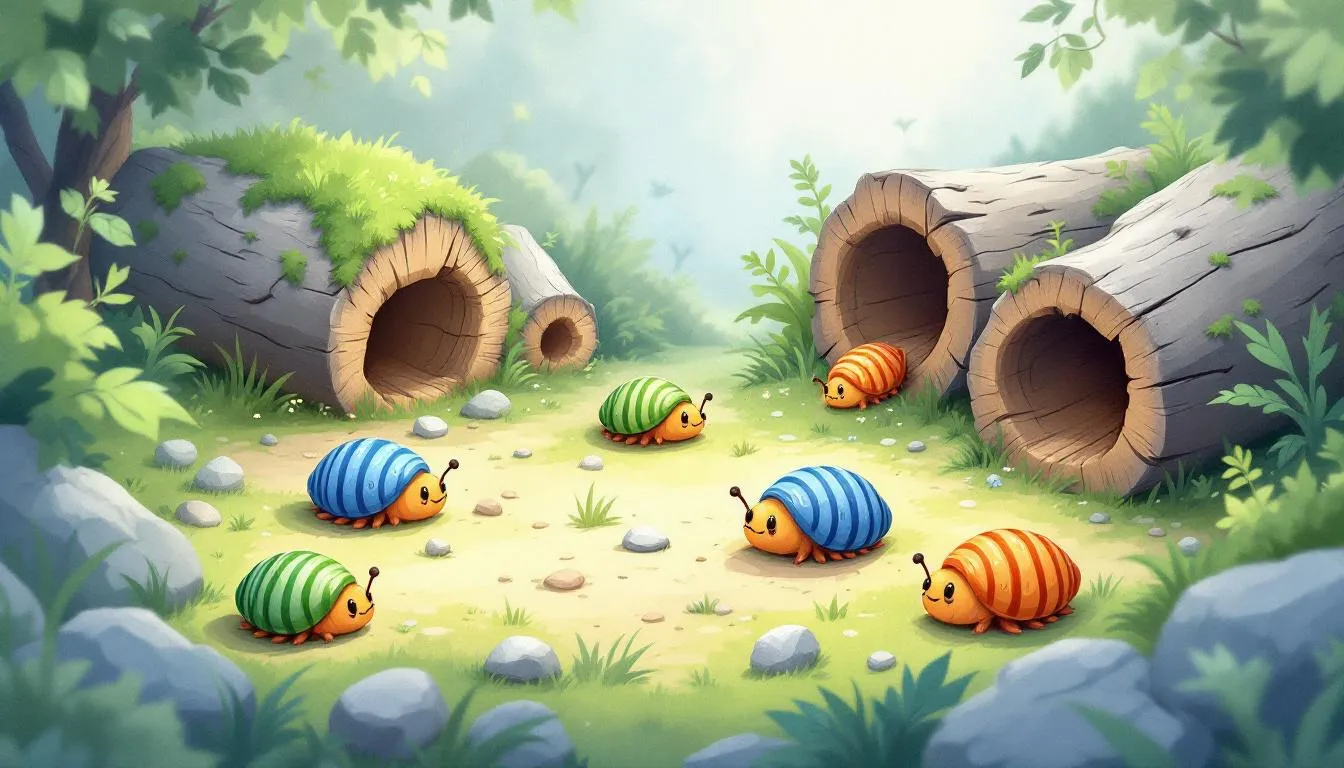Exploring Big Woodlice: Fascinating Facts and Habitats
Big woodlice are large terrestrial isopods that play crucial roles in ecosystems. Known for their ability to roll into a ball, these creatures are found in various habitats from gardens to coastlines. In this article, we delve into the unique features and ecological importance of big woodlice.
Key Takeaways
-
Woodlice are terrestrial isopods, not insects, with diverse species exhibiting unique adaptations and social structures.
-
These organisms play a crucial ecological role as decomposers, improving soil health and nutrient cycling through their feeding habits.
-
Woodlice have evolved several defensive mechanisms, such as conglobation and camouflage, to enhance their survival against predators in various habitats.
Understanding Big Woodlice

Woodlice, often mistaken for insects, are actually terrestrial isopod group of crustaceans that have adapted to live on land. These creatures typically have fourteen legs, gaining a pair after their first moult during development. While they may appear solitary, woodlice living in colonies showcase a fascinating social structure. Their average lifespan ranges from two to three years, during which they undergo significant evolutionary changes. Arthropods like woodlice demonstrate remarkable adaptability to terrestrial environments.
Exploring the basic biology and social behavior of woodlice highlights the diversity among different species. Examining their physical characteristics and life cycles reveals how these creatures and animals have adapted to thrive in environments ranging from damp gardens to rocky coastlines.
Common Shiny Woodlouse

The common shiny woodlouse, one of the largest native woodlice in Britain, can reach a length of up to 16 millimeters. This species is easily recognizable by its shiny brown-grey coloration, which helps it blend into its moist, decaying wood habitats. These woodlice thrive in various damp environments, from gardens to woodlands, showcasing their adaptability.
Woodlice in these habitats helps break down decaying plant material, aiding soil health and nutrient cycling. Their presence in gardens and natural areas underscores their role in maintaining ecological balance and how they eat contributes to this process. This is vital for the lives of many organisms, plants, and the earth.
Found under garden shed and among woodland leaf litter, the common shiny woodlouse exemplifies the resilience and adaptability of these terrestrial isopods, often found on the underside of decaying leaves. The common pygmy woodlouse and the common striped woodlouse are other examples of these fascinating creatures, which can sometimes be found in half the usual numbers. This woodlouse belongs to the genus of terrestrial isopods.
Pill Woodlouse: The Giant Rollers
Pill woodlice, often referred to as pill bugs, are notable for:
-
Their ability to roll into a ball, a defensive mechanism known as conglobation.
-
Being relatively large woodlice, measuring around 18mm in length.
-
Commonly being found in dry habitats, often under leaf litter or on walls.
This ability not only shields them from predators but also helps retain moisture in dry conditions.
These woodlice are intriguing, especially when they curl into balls, resembling miniature armadillos. Woodlice found in diverse habitats from urban gardens to natural forests, they break down organic matter, contributing significantly to soil health.
Rough Woodlouse: The Bumpy Giants

The rough woodlouse, with its dark grey coloration and distinctly bumpy texture, is another fascinating member of the woodlouse family. These creatures have a distinctive oval shape and a dimpled exoskeleton, making them easily recognizable. Rough woodlice thrive in dark, damp environments, often beneath stones and in leaf litter, contributing to decomposition.
Their rough exterior not only provides protection against predators but also aids in moisture retention, allowing them to survive in their preferred habitats. Through breaking down organic material, rough woodlice significantly support nutrient cycling, aiding ecosystem health and vitality.
Armadillidium vulgare: The Little Armadillo
Armadillidium vulgare, often referred to as the common woodlouse, is a remarkable species known for its ability to curl into a ball, much like its namesake, the armadillo. This species features:
-
An oval body shape, generally twice as long as it is wide
-
A mature length of about 10 mm
-
An armor-like structure composed of seven plates, providing both protection and flexibility.
This species is not endangered and does not have any special conservation status, indicating its widespread presence and adaptability. Armadillidium vulgare is commonly found in temperate climates and has been introduced globally, thriving in various environments. Present in gardens and various habitats, they play a key role in decomposition, contributing to soil health and ecosystem stability.
Studying Armadillidium vulgare’s characteristics and behaviors provides insight into the evolutionary adaptations that have enabled woodlice to thrive in diverse environments. Their ability to curl into a ball and their robust exoskeleton showcase their evolutionary ingenuity.
Sea Slaters: Coastal Giants
Sea slaters are fascinating woodlice that thrive in rocky coastal environments, often found under boulders and cliffs. These creatures play a significant role as scavengers, consuming various organic materials, including seaweeds and decaying matter. Their diet primarily consists of:
-
brown seaweeds
-
mosses
-
lichens
-
dead animal material This diet makes them essential in maintaining the health of coastal ecosystems.
Sea slaters use color variation to camouflage in their rocky habitats, adapting to varying light conditions. They usually emerge during the night, particularly in dark, moonless conditions to avoid predators. Their nocturnal habits and ability to blend into their surroundings make the sea slater intriguing subjects for studying adaptation and survival in harsh coastal environments.
Evolution and Adaptation of Large Woodlice
Woodlice are a unique group of terrestrial isopods that evolved from marine ancestors, showcasing a remarkable evolutionary journey. Their specialized respiratory system, including pleopodal lungs, enables survival in terrestrial habitats. The hard exoskeleton and unique respiratory system of woodlice are key adaptations that have enabled them to thrive in various environments.
Molting, the process of shedding an exoskeleton, is a critical part of the woodlice life cycle. This process not only allows them to grow but also to repair damaged body parts. Understanding these evolutionary adaptations deepens our appreciation for the resilience and intricate mechanisms supporting woodlice survival in various habitats. The ability to molt is essential for their development.
Habitat Preferences of Large Woodlice

Large woodlice mainly inhabit damp, dark environments to prevent desiccation. Commonly found in temperate climates, they prefer habitats that remain damp year-round. These creatures thrive in environments with high humidity and abundant decomposing organic matter, such as leaf litter, under stones, and logs.
Certain large woodlice species and several species are adapted to coastal beach habitats, tolerating brackish conditions. Nocturnal by nature, they stay hidden during the day to avoid desiccation and predation.
Recognizing woodlice habitat preferences enhances our appreciation of their role in ecological balance and the importance of preserving their environments.
Diet and Feeding Habits
Woodlice are nature’s recyclers, primarily feeding on decaying plant material, which is vital for ecosystem health. Armadillidium vulgare, for instance, has a diet consisting mainly of decaying plant material, making them important detritivores. Woodlice enrich soil nutrients by breaking down organic matter, playing a crucial role in nutrient cycling.
In gardens, woodlice enhance soil health by breaking down leaf litter and organic debris. Their dietary habits and behaviors include:
-
Adapting their diet to include organic materials like human food scraps when living in homes
-
Primarily being detritivores but occasionally consuming soft plant parts if decaying materials are scarce
-
Exhibiting coprophagic behavior, eating their feces to maximize nutrient absorption
These behaviors further underscore their adaptability.
Different species of woodlice have varied dietary preferences, often consuming specific types of fungi and organic detritus. Understanding their dietary habits enhances our appreciation of woodlice’s ecological importance and their role in maintaining healthy ecosystems.
Predators and Defense Mechanisms
Woodlice have evolved several defense mechanisms to survive against predators. The primary defense mechanism is their ability to roll into a ball, a behavior known as conglobation. This not only protects them from predators but also helps retain moisture in dry conditions.
Besides conglobation, woodlice use their gray or black coloration to blend into their surroundings for camouflage. These defenses, along with their nocturnal habits, help woodlice evade predators and survive in various habitats.
Conservation and Importance in Ecosystems

Woodlice play an important role as decomposers, feeding on dead plant material and contributing to nutrient recycling. Armadillidium vulgare, for example, plays a significant ecological role as a seed predator, influencing plant population growth. The conservation status of woodlice is generally stable, indicating they are common in various habitats.
Through breaking down organic matter, woodlice maintain soil health and support their ecosystems. Their role as decomposers highlights their important part in nutrient cycling and the overall health of the earth’s ecosystems. Recognizing their ecological significance highlights the need for conservation and habitat preservation.
Summary
In summary, woodlice are remarkable creatures that play a crucial role in our ecosystems. From the common shiny woodlouse to the coastal sea slaters, these terrestrial isopods exhibit incredible adaptability and resilience. Their evolutionary journey, dietary habits, habitat requirements (creating the perfect habitat), and defense mechanisms highlight their importance in maintaining ecological balance.
As we continue to explore and understand these fascinating creatures, it becomes clear that woodlice are more than just garden dwellers. They are vital contributors to soil health and nutrient cycling, ensuring the sustainability of our ecosystems. By appreciating and conserving woodlice, we support the intricate web of life that sustains our planet.
Frequently Asked Questions
What are woodlice, and how are they different from insects?
Woodlice are terrestrial isopods belonging to the crustacean family, which sets them apart from insects. Unlike insects, woodlice possess fourteen legs and a hard exoskeleton.
Where can I commonly find woodlice?
You can commonly find woodlice in damp, dark environments like under decaying wood, leaf litter, stones, and logs, as they thrive in humid conditions with plenty of decomposing organic matter.
What do woodlice eat?
Woodlice predominantly consume decaying plant material and fungi, playing a crucial role as detritivores in the ecosystem. Additionally, they may eat organic detritus and soft plant parts when necessary.
How do woodlice defend themselves from predators?
Woodlice effectively defend themselves from predators by rolling into a ball, known as conglobation, and by camouflaging with their surroundings, enhancing their evasion tactics. These mechanisms not only protect them but also help them retain moisture in their habitat.
What role do woodlice play in ecosystems?
Woodlice are essential decomposers in ecosystems, as they break down organic matter and enrich soil nutrients. Their activity supports soil health and contributes significantly to nutrient cycling and ecosystem stability.









